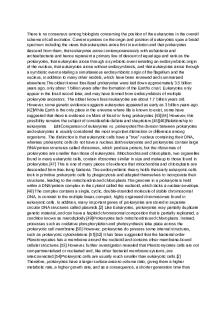Sugar Cyclization - Lecture notes 5 PDF

| Title | Sugar Cyclization - Lecture notes 5 |
|---|---|
| Author | Olga Nelson |
| Course | Biochemistry |
| Institution | University of Arizona |
| Pages | 1 |
| File Size | 39.3 KB |
| File Type | |
| Total Downloads | 3 |
| Total Views | 131 |
Summary
All my notes from the semester...
Description
SUGAR CYCLIZATION -> RING As a carbohydrate with six carbon atoms, glucose, for example, belongs to the hexoses. As an aldose, glucose has an aldehyde group on the first carbon atom. An intramolecular hemiacetal formation results in a ring: in the pyranose form, the first carbon atom is connected to the fifth, in the rarer form, the first carbon atom is connected to the fourth via an oxygen bridge. The carbonyl oxygen of the aldehyde group thereby becomes the hydroxyl group. Sugar molecules with a number of C atoms of 5 or more (e.g. glucose as C6 compound) are predominantly present in a cyclic structure in which the carbon (C-1) of the aldehyde group is covalently bonded to the oxygen of the hydroxyl group at carbon C-5 (asymmetric carbon). General reaction of cyclization represents a hemiacetal formation reaction aldehyde with an alcohol (it is not a condensation reaction, because no molecule is split off): The carbonyl group of the sugar reacts with the oxygen of the C-5 to form a hemiacetal (half ketal). The oxygen in the ring structure is formed by the C5-OH, a covalent bond is formed with the oxygen of the hydroxyl (OH) group.
SUGARS - FORMATION OF ANOMERS Sugars with 5 or more C atoms exist completely in the solid state and almost completely in the cyclic hemiacetal form in solution. Cyclization leads to the formation of another new center of asymmetry at C-1, which is not present in the open-chain form. The corresponding isomers are called α-. Not all ring atoms lie in the same plane. Rather, pyranose rings usually adopt an armchair conformation and rings adopt an "envelope" conformation. In aqueous solution, the ring can be opened and closed so that there is an equilibrium between pyranose (six-membered ring with oxygen atom, 99.75%), (five-membered ring, in trace amounts), and open-chain aldehyde (0.25%) forms. The addition of acid or alkali accelerates this process. Since either the alpha or beta form can be formed during ring closure, there is also an equilibrium between alpha form (36.4%) and beta form (63.6%). The equilibrium is on the side of β-D-glucose, as can be seen from the percentages. It is the more stable, since all hydroxyl groups are arranged equatorially in the armchair conformation and are thus the greatest possible distance apart. The fact that the α- is still present at 36.4% despite the axial OH group indicates that there must be other influences. The relative stability of the α-configuration is called anomic effect...
Similar Free PDFs

That sugar film notes
- 7 Pages

5 - Lecture notes 5
- 4 Pages

Sugar and sugar products doc
- 9 Pages

Chapter 5 - Lecture notes 5
- 15 Pages

Chapter-5 - Lecture notes 5
- 6 Pages

Chapter 5 - Lecture notes 5
- 83 Pages

Tutorial 5 - Lecture notes 5
- 3 Pages

Chapter 5 - Lecture notes 5
- 4 Pages

Imagen 5 - Lecture notes 5
- 1 Pages

Quiz 5 - Lecture notes 5
- 11 Pages

Chapter 5 - Lecture notes 5
- 20 Pages

Chapter 5 - Lecture notes 5
- 4 Pages

Lesson 5 - Lecture notes 5
- 22 Pages

5 Statehood - Lecture notes 5
- 4 Pages

Prokaryotes 5 - Lecture notes 5
- 2 Pages
Popular Institutions
- Tinajero National High School - Annex
- Politeknik Caltex Riau
- Yokohama City University
- SGT University
- University of Al-Qadisiyah
- Divine Word College of Vigan
- Techniek College Rotterdam
- Universidade de Santiago
- Universiti Teknologi MARA Cawangan Johor Kampus Pasir Gudang
- Poltekkes Kemenkes Yogyakarta
- Baguio City National High School
- Colegio san marcos
- preparatoria uno
- Centro de Bachillerato Tecnológico Industrial y de Servicios No. 107
- Dalian Maritime University
- Quang Trung Secondary School
- Colegio Tecnológico en Informática
- Corporación Regional de Educación Superior
- Grupo CEDVA
- Dar Al Uloom University
- Centro de Estudios Preuniversitarios de la Universidad Nacional de Ingeniería
- 上智大学
- Aakash International School, Nuna Majara
- San Felipe Neri Catholic School
- Kang Chiao International School - New Taipei City
- Misamis Occidental National High School
- Institución Educativa Escuela Normal Juan Ladrilleros
- Kolehiyo ng Pantukan
- Batanes State College
- Instituto Continental
- Sekolah Menengah Kejuruan Kesehatan Kaltara (Tarakan)
- Colegio de La Inmaculada Concepcion - Cebu
